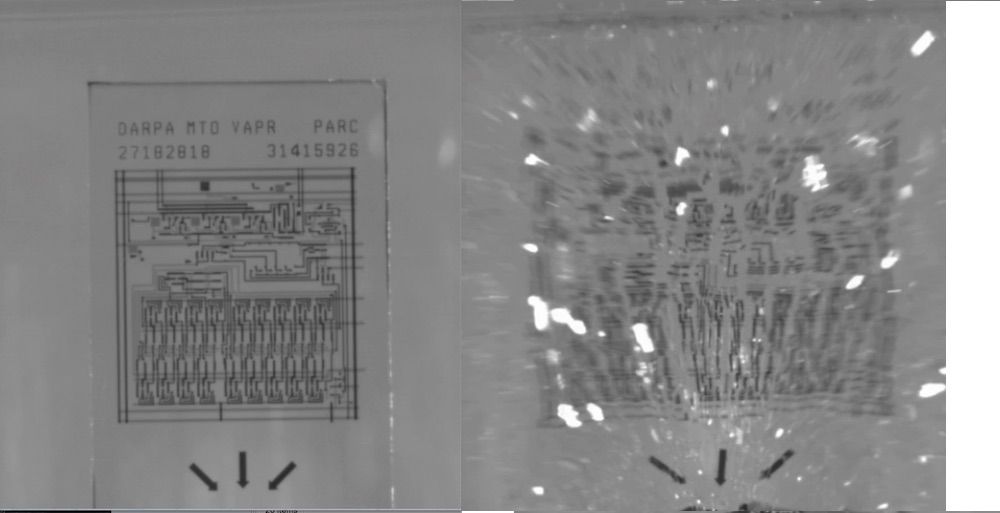
Self-destructing in 3…2…1. Boom!
A new technology can make computer chips self-destruct when remotely triggered. The new method uses silicon computer wafers attached to a piece of tempered glass that shatters into smithereens when heated in one spot.
The heat can be turned on via a remote, which in the future could conceivably be triggered by anything from Wi-Fi to a radiofrequency signal, said Gregory Whiting, a materials scientist and manager of the Novel Electronics Group that produced the chip at PARC, a Xerox company. The self-destructing chip was on display last month at DARPA's "Wait, What? Technology Forum" in St. Louis. [Watch the Self-Destructing Chip Explode Into Teensy Pieces]
The new technology could allow for easier recycling of electronics, or help ensure that data on stolen electronics remains secure, Whiting said.
Tempered glass
The team was initially inspired to make self-destructing electronics that could be built with off-the-shelf products, Whiting said. The researchers considered a number of methods of destruction, from vaporization to dissolving, but "we approached this from the idea of, 'Could we take an off-the-shelf chip, if you like, and, without doing too much to it, could we make it become transient?'" Whiting told Live Science.
The team came upon the idea of tempered glass, an extra strength material also known as safety glass. Normally, people temper glass by cooling the edges: The glass exterior shrinks, putting the exterior into compression while the warmer interior maintains incredible tensile stress.
Sign up for the Live Science daily newsletter now
Get the world’s most fascinating discoveries delivered straight to your inbox.
Though the glass is stronger than normal, "if you break a piece of safety glass, it kind of explodes, shatters explosively into little pieces," Whiting said.
Because glass is a poor temperature conductor, the heat-tempering process only works with pieces of glass that are at least 0.03 inches (1 millimeter) thick, whereas producing tiny particles requires thinner materials.
As such, the team used a different method, called ion exchange, to temper the glass. The researchers started with a thin piece of glass that was rich in sodium ions, or atoms of sodium with one electron stripped off. They then put the glass into a hot bath of potassium nitrate. Potassium ions then try to swap places with the sodium ions, but because the heftier potassium ions must squeeze into place within the silicon matrix, this creates enormous tension in the glass, Whiting said.
The new method allows people to either attach silicon wafers directly to the glass, or fabricate the two together. (The final chip looks like a piece of glass with some metal lines drawn all over it.)
To induce chip suicide, the team triggers the chip with a tiny heating element, which causes a thermal shock that creates a fracture that spreads throughout the glass. The current demonstration uses a piece of glass that is 250 micrometers thick, but theoretically, any size glass could be used, Whiting said. (For comparison, an average strand of human hair is about 80 to 100 micrometers thick.)
In addition, anything from Wi-Fi to radio waves could send the kill signal to the chip, Whiting said.
Remote destruction
Of course, many might wonder: Why not take the old-fashioned route and take a sledgehammer to the electronic device?
"You can throw your phone into some boiling water, or you can smash it on the floor, you can even apply a high-current pulse to try and burn up the memory," Whiting said.
But even though all those methods may be more low-tech (and potentially more therapeutic) than a self-destructing computer chip, they can't be implemented from afar.
And, barring using an acid to dissolve the object, it's actually pretty hard to completely destroy information on an electronic device using most methods, Whiting said.
"People are pretty strongly able to recover that information, because the bits are still in order," Whiting said, referring to the base unit of information on a silicon chip.
By contrast, the self-destructing glass chip shatters into such tiny pieces that the method "doesn't just wipe the data, it sort of rearranges the bits," Whiting said. Some of the debris is so tiny that it destroys many of the bits altogether. Reconstructing the data would require putting all those tiny particles back together, he added.
Follow Tia Ghose on Twitterand Google+. Follow Live Science @livescience, Facebook & Google+. Original article on Live Science.

Tia is the managing editor and was previously a senior writer for Live Science. Her work has appeared in Scientific American, Wired.com and other outlets. She holds a master's degree in bioengineering from the University of Washington, a graduate certificate in science writing from UC Santa Cruz and a bachelor's degree in mechanical engineering from the University of Texas at Austin. Tia was part of a team at the Milwaukee Journal Sentinel that published the Empty Cradles series on preterm births, which won multiple awards, including the 2012 Casey Medal for Meritorious Journalism.










